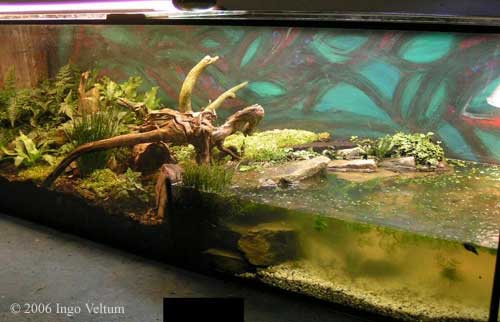Glass Divider Setups
Glass Divider Setup #1
 |
Dimensions: ~30 gallons; 30x12x18 inches (75x30x45 cm) Animals: adult Tylototriton shanjing Owner: Gord Ellis Comments: It has a glass divider siliconed in. I siliconed smooth granite rocks to the divider. The land side is filled out by styrofoam to keep it light. The substrate is a mix of jungle earth, coconut mulch, soil, leaf mulch, and birch leaves. The water side has gravel and is bordered at the back by a large piece of driftwood and a smaller piece of malaysian wood. The newts can crawl across the back of the water section and stay dry. The pool is small, but could be expanded by adding water. The pond has elodea in it. The plants on the land side are ferns, a tropical plant, and various clippings of Pothos etc. An apple tree limb is there for the Pothos to wrap on. I have a Ficus hyrdoponically set in the water. I've used silk plants for more cover on the glass. The tank stays at about 70°F (21°C) during the day and drops to the mid 60s at night. It is screened and has a 15-watt lamp. I mist the tank each morning for moisture. The two T. shanjing are thriving in this set up. |
Glass Divider Setup #2

 |
Dimensions: 140x60x70 cm; 56x24x28 inches Animals: various Triturus Owner: Yago Comments: This setup is a display tank in my studio and also an ideal setup for breeding and monitoring. Every year I clear and adapt the setup to house a different species that I want to breed, monitor, photograph, and record. All my other setups are much simpler, but I reckon that people will also appreciate information on bigger and more complex setups. It has a undergravel filter, an exterior biomechanical filter, and a chiller that can drop temperatures up to 2°C in winter. The aquarium is built using climalit glass, 2 separate glasses with an air space. It keeps the aquarium isolated from temperatures and sounds and there is no need to worry about condensation. The land area is an independent glass platform. I used all the available space for water and more than half of the aquarium is also land area. The newts enjoy the water cave area under the terrestrial area, which is always dark. The land area is made of volcanic gravel, on top there is a plastic mesh which supports the carbon which works to neutralize toxins, then another layer of plastic mesh and finally the compost layer with plants, rocks, and moss. I also put two tubes in different places on the terrestrial platform which I use to take away the extra water. The lighting is controlled with 4 different timers, one for each fluorescent. These create a light period and intensity that varies with the season. One of the fluorescents is a moonlight bulb for the very first and last light of the day. |
Glass Divider Setup #3

 |
Dimensions: 100x40x50 cm; 40x16x18 inches Animals: Adult Notophthalmus viridescens Owner: Ester van Strien Comments: Two rectangular pieces of glass are put vertically against the corners in the back to create room for plants. A rectangular piece of glass is resting on top to provide a land bridge. |
Glass Divider Setup #4
 |
Volume: 20-gallon long Dimensions: 75x30x30 cm Animals: Juvenile Triturus karelinii Owner: Jennifer Macke Comments: As shown, this design is not recommended. This tank would have been far better with a taller piece of glass and a false bottom (or additional water area) under the land area. The water area was not big enough, and the land area was always filling with water. |
Glass Divider Setup #5
 |
Volume: 20-gallon long Dimensions: 75x30x30 cm Animals: Adult Triturus karelinii Owner: Jennifer Macke Comments: This is the same tank as #4, but without the soil. A small submersible filter (Duetto 50) moves water from the lower side to the upper side. |
Glass Divider Setup #6
 |
Volume: 20-gallon long Dimensions: 75x30x30 cm Animals: 5 Triturus karelinii Owner: Jennifer Macke Comments: First, small glass rods were cemented horizontally to the sides of the tank. Then the large glass plate was cemented in place on top of the rods. A smaller vertical plate makes the land area deep enough for dirt and plants on top. |
Glass Divider Setup #7
 |
Volume: 10 gallons; 40 liters Animals: made for 2 adult Triturus marmoratus Owner: Jennifer Macke Comments: This design preserves the full volume of the tank for water, while also providing a substantial land area. The sloping glass plate makes it easy for the animals to find their way to the surface. Step by step instructions for making this tank are posted here. |
Glass Divider Setup #8
 |
Volume: Unknown Animals: Unknown Owner: Ingo Veltum Comments: |
Glass Divider Setup #9
 |
Size: 48 x 16 inches (120 x 45 cm) Animals: 5 adult Tylototriton kweichowensis Owner: Andrew Baker Comments: "The water area was created with glass, and on the glass I spread a mixture of aquarium silicone and river sand. The tank also has a lot of ventilation. I use the tank more to house the animals over their winter dormant period; during the spring/summer they're in an aquatic tank for breeding." |
Glass Divider Setup #10
 |
Volume: Unknown Animals: Unknown Owner: Ingo Veltum Comments: |
For more setup photos, see Setting It Up.
